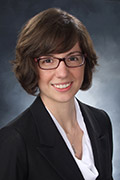CV: Dr. Meaghan O’Reilly
By Eleni Kanavas
Bio basics: A scientist in Physical Sciences and the Holland Musculoskeletal Research Program at Sunnybrook Research Institute (SRI) and assistant professor at the University of Toronto. Completed her PhD in applied physics at the University of Eastern Finland; a M.Sc. in biomedical engineering at the University of Oxford in the U.K. and a B.Sc. in mechanical engineering at Queen’s University. Grew up in Scarborough, Ontario with four brothers and a sister.
As a former research associate at SRI, how does it feel to be appointed a scientist?
I’m looking forward to starting my own research group, which is equally exciting and a little frightening too. The spine is an interesting area for ultrasound therapy that has been sparsely investigated. There’s a lot of potential in taking the drug delivery work that we’re doing in the brain and applying it to the treatment of conditions like amyotrophic lateral sclerosis, spinal cord injury or spinal muscular atrophy.
What is your research focus?
It’s centered around drug delivery applications in the brain with a focus on the physics and engineering aspects. We’re using ultrasound to facilitate drug penetration through the blood-brain-barrier, and the work has reached a stage where researchers are very close to implementing the technique in patients. There is an equivalent spinal cord barrier, but the geometry of the spinal column is much more complex than the skull. Where it becomes very interesting from an engineering standpoint is how do we design systems and transducers to specifically target the spinal canal.
With whom do you collaborate at SRI?
Through my work with Dr. Kullervo Hynynen, I’ve worked with Dr. Isabelle Aubert quite a bit. I’m looking forward to working with other scientists. The exciting part about being an independent investigator and starting out on your own is reaching out and using all the available resources.
Why SRI?
The facilities are a step above anything that I’ve had access to in any other research position. I like that it’s a hospital-based research institute. You could do research at a university, but being right in the hospital, there’s a lot of integration with clinicians, as well as a lot of potential for translating the work and having it used in the clinic.
What interested you in becoming a researcher?
What I really like about engineering is the problem solving. We’re doing new things that people haven’t thought of before. That sort of curiosity is what really makes me passionate about research.
If you were not a scientist, then which profession would you choose?
That’s a tough question. I briefly considered applying to theatre programs. I have an associate diploma in speech and drama performance from Trinity College London. I really enjoyed that but I don’t think I could do it as a career.
What activities or hobbies do you enjoy outside of work?
I’m a hockey player. This is what happens when you have brothers. I’m a cyclist and also a knitter and a hand-weaver.
What advice do you have for students and trainees in science?
Work hard and find a research area that you’re passionate about because then it becomes very enjoyable.



